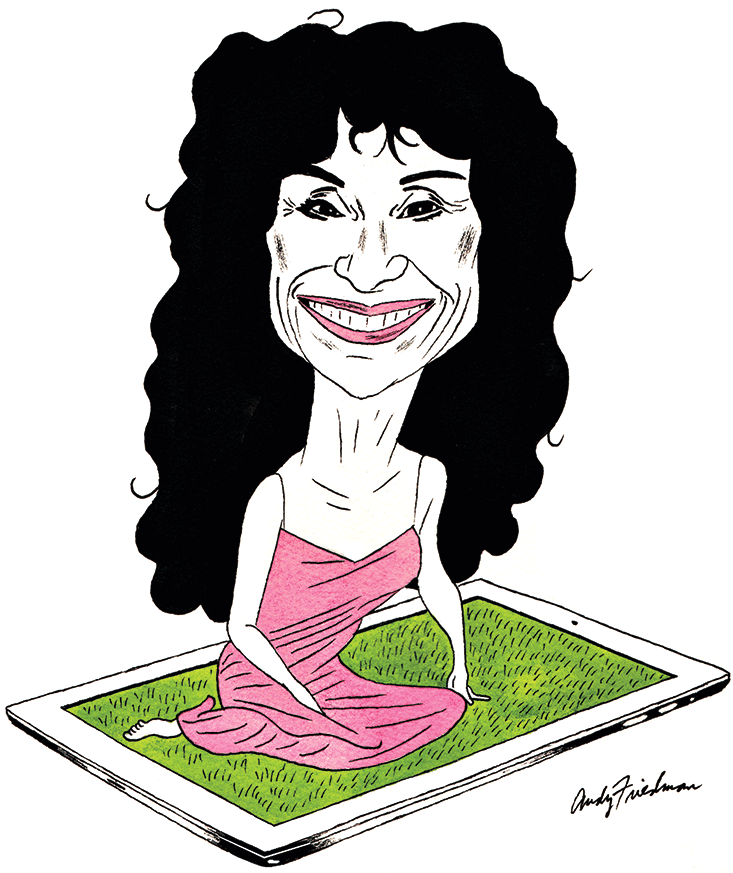For three decades Diane Ackerman has brought us as close to nature as we can get through words. Her books are not a field guide to the natural world, they are an embodiment of it. As she showed with, among others, A Natural History of the Senses and The Zookeeper’s Wife, about Polish zookeepers who saved hundreds of people during World War II, she is less an observer from the outside than a voice from the inside. You don’t read her books as much as live them.
In her latest, The Human Age, Ackerman embeds herself in a world “radically, irreversibly” remade by us. “At every level, from wild animals to the microbes that homestead our flesh, from our evolving homes and cities to virtual zoos and webcams, humanity’s unique bond with nature has taken a new direction,” she writes.
Anxious to see the future through Ackerman’s eyes, we asked her to comment on the themes that make up the Fall 2014 Nautilus Quarterly: Mutation, Turbulence, and Symmetry. In her accompanying online essay, “Nature, Pixilated,” she causes us to reevaluate our relationship to the world when “we’re mainly experiencing nature through intermediary technology that, paradoxically, provides more detail while also flattening the senses.”
On Mutation
We’ve been tailoring plants and animals to suit our palate, needs, whims, and existential loneliness for a very long time. Through the process of eugenics, we’ve been busily breeding different life forms to produce offspring with the traits we prefer. The first wild corn looked nothing like the colossal ears we enjoy now, and heaven knows Chihuahuas, dachshunds, and Bedlington Terriers look little like their lupine ancestors. However, we were always tinkering with single species.
What’s different now is that we can mix the DNA from completely unrelated species, and we don’t know yet what biological whirlwinds that may unloose. We want the benefits of genetic engineering—removing the facial cancer gene that plagues the critically endangered Tasmanian devils, for instance, or fixing a child’s hereditary horror, or breeding mosquitos free of the gene for dengue fever—but do we really need tomatoes with salmon genes swimming around inside of them, or animals that glow green, or sterile seeds farmers have to keep buying every year? We’re much better at tampering with nature than understanding it, so we need to be especially careful about how we continue modifying the planet’s life forms.

On Turbulence
In only 200 years humankind has become the dominant source of change on the planet. We’ve left our signature everywhere: altering the climate and oceans, redrawing the outline of continents, rerouting rivers, lopping off the tops of mountains, rearranging plants and animals, causing mass extinctions, even creating new forms of matter. We’re suddenly in the midst of a majestic Information Age, but also a sustainability revolution, a nanotechnology revolution, a 3D revolution in manufacturing, a revolution in how we examine and imagine the body. There’s also the disturbing evidence of climate change and mass extinction of animals, among countless other discoveries, inventions, worries, shocks, uncertainties, and new normals. These are turbulent times, indeed. But that also makes it a rich and exciting time to be alive. We humans have a turbulent nature. We’ve always been hopped up, meddling busy-bodies who were passionate, curious, headstrong, impulsive, endlessly inventive, compassionate, deeply loving, and easily bored. Evolution is an inherently turbulent biological process. So is human nature. What a combo. I think we should always expect the unexpected.
On Symmetry
Because we live on a planet whose gravity works against us, pulling us down, finding the perfect balance for walking or climbing is easier for symmetrical beings. Symmetry also makes life steadier for snowflakes, riverbanks, mountain goats, crabs, honeycombs, and romanesco broccoli. We find special beauty in the chaos of fractals’ perfect symmetry, or a diamond’s house-of-mirrors dazzle. We boast bilateral symmetry, and come equipped with two eyes, ears, arms, legs, lungs, kidneys, eyebrows, breasts, two hemispheres of the brain with a superhighway yoking them, two hips and bone wings of the pelvis to spare the torso pain, two vas deferens (or the vast difference of ovaries). But they’re not perfectly alike in anyone.
In nature, symmetry is often near symmetry, the glancing sameness of identical twins, not perfect clones. And although I was taught in biology that we prefer more symmetrical faces because we equate their balance with good health, this isn’t always true. We also applaud the beauty of some actors with lopsided faces, and a craggily interesting face, even if it’s lined like a Shar Pei’s, may appeal because it resembles a loved one’s. Fortunately for some of us, nature favors both perfect and imperfect symmetries. Symmetry applied to human nature is always imperfect, but no less powerful for that. As a species, for instance, we’ve created a lot of planetary chaos we didn’t mean to, we’ve sullied our environment and knocked Earth’s climate way out of balance. But a vital symmetry gives me abundant hope: Our inventiveness got us into this mess, and we can refocus our inventiveness to get us out.
Kirsten Weir is a freelance science writer in Minneapolis.



